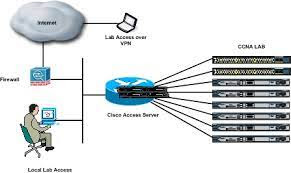Bandung, Telkom University - An access server like the Cisco 2509 or 2511 is one of the best investments you can make when expanding your CCNA/CCNP home lab. This article covers the basic configuration of the access server and how to use AS to connect to other routers and switches in the pod.
This is part of the configuration from one of my access servers.
- IP host FRS 2006 100.1.1.1
- IP host SW2 2005 100.1.1.1
- IP host SW1 2004 100.1.1.1
- IP host R2 2002 100.1.1.1
- IP host R1 2001 100.1.1.1
- IP host R3 2003 100.1.1.1
- Loopback 0 interface
- IP address 100.1.1.1 255.255.255.255
- ip-directed-no broadcast
This is the IP host table and this is how the whole AS setup works. The PC is connected to the access server, and the access server is physically connected to other routers and switches with octal cables.
One end of the octal cable is spliced into eight separate cables, each terminated with an Rj-45 connector. This connector connects to the console port of one of your home lab devices. In this configuration, I connected connector 1 to R1's console port, connector 2 to R2, connector 3 to R3, connector 4 to Sw1, and so on. (Ports are also physically numbered.)
The IP host table entry here is associated with the loopback address shown. The loopback can be any address, but must match the IP host table address. This allows you to create reverse Telnet sessions to routers and switches.


